Java Review - PriorityQueue源码解读
Posted 小小工匠
tags:
篇首语:本文由小常识网(cha138.com)小编为大家整理,主要介绍了Java Review - PriorityQueue源码解读相关的知识,希望对你有一定的参考价值。
文章目录

Pre
Java Review - Queue和Stack 源码解读
PriorityQueue 概述
Java Review - Queue和Stack 源码解读以Java ArrayDeque为例讲解了Stack和Queue,还有一种特殊的队列叫做PriorityQueue,即优先队列。
优先队列的作用是能保证每次取出的元素都是队列中权值最小的。
那大小关系如何评判呢? 元素大小的评判可以通过元素本身的自然顺序(natural ordering),也可以通过构造时传入的比较器
PriorityQueue 继承关系
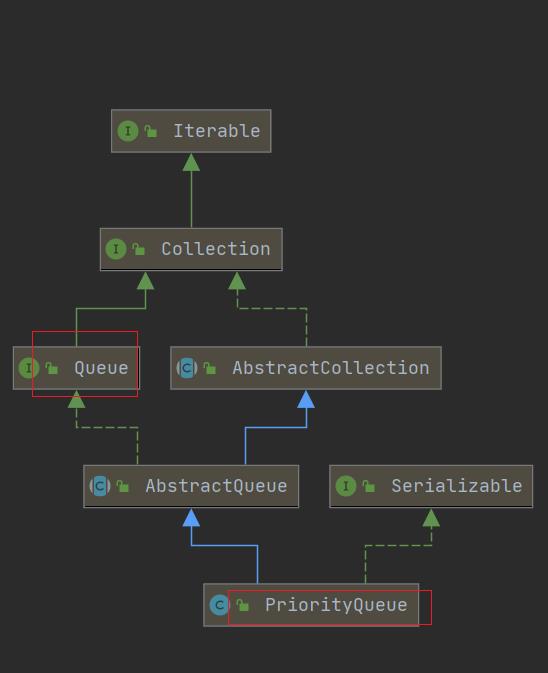
PriorityQueue通过用数组表示的小顶堆实现
-
PriorityQueue实现了Queue接口,不允许放入null元素;
-
其通过堆实现,具体说是通过完全二叉树(complete binary tree)实现的小顶堆(任意一个非叶子节点的权值,都不大于其左右子节点的权值),也就意味着可以通过数组来作为PriorityQueue的底层实现
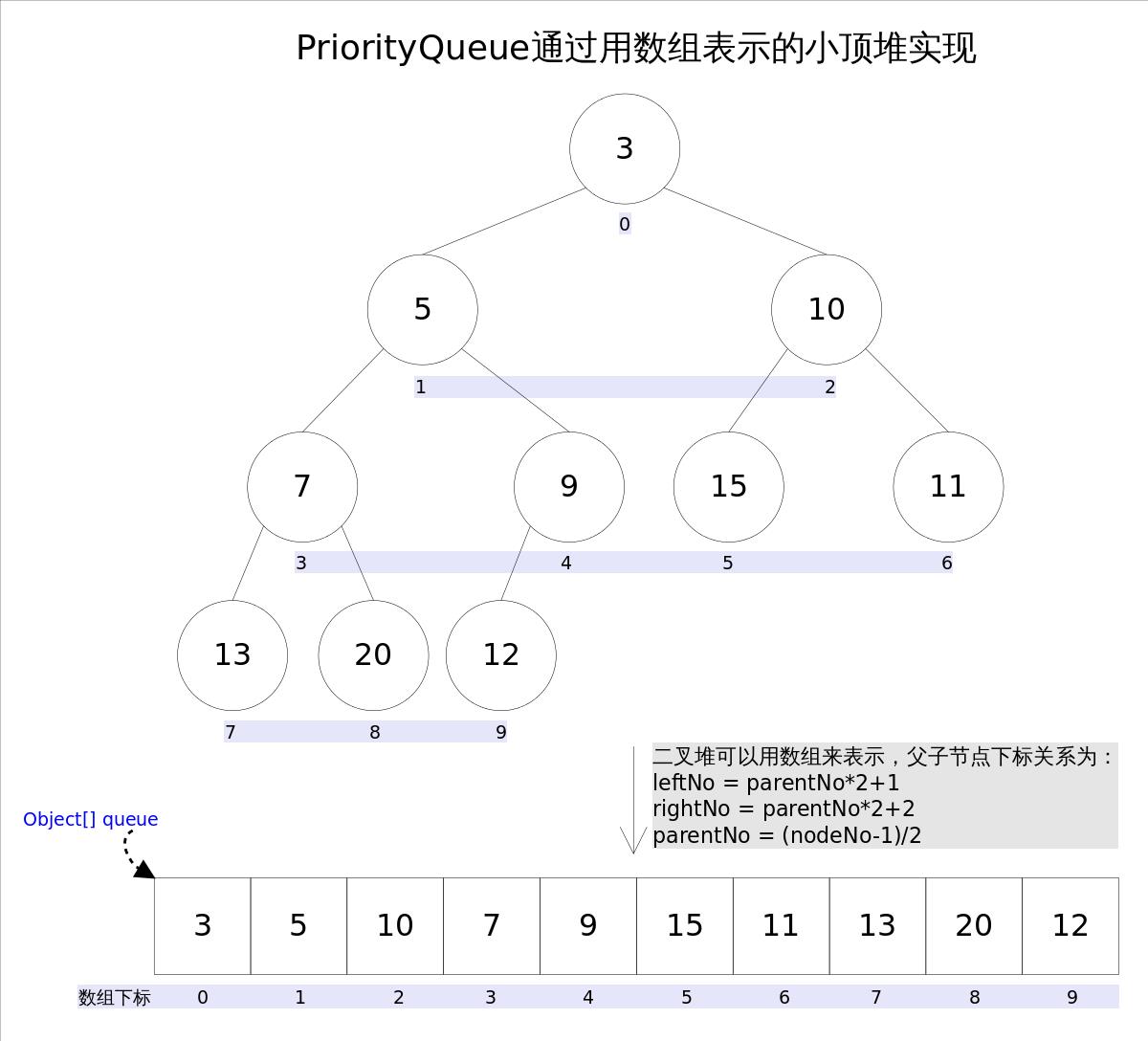
上图中我们给每个元素按照层序遍历的方式进行了编号, 会发现父节点和子节点的编号是有联系的,更确切的说父子节点的编号之间有如下关系:
leftNo = parentNo*2+1
rightNo = parentNo*2+2
parentNo = (nodeNo-1)/2
通过上述三个公式,可以轻易计算出某个节点的父节点以及子节点的下标。这也就是为什么可以直接用数组来存储堆的原因。
时间复杂度
-
peek()和element操作是常数时间,
-
add(), offer(), 无参数的remove()以及poll()方法的时间复杂度都是log(N)
构造函数
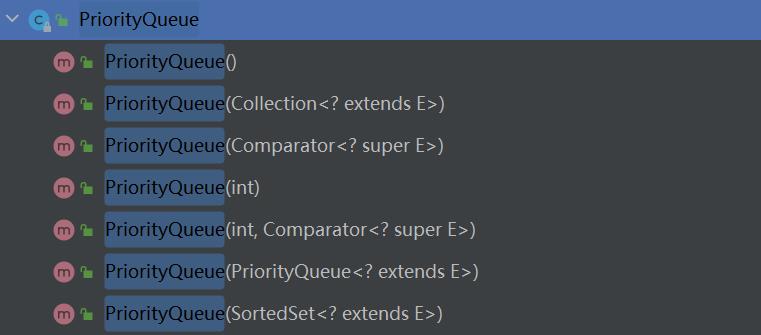
private static final int DEFAULT_INITIAL_CAPACITY = 11;
/**
* The comparator, or null if priority queue uses elements'
* natural ordering.
*/
private final Comparator<? super E> comparator;
/**
* Creates a @code PriorityQueue with the default initial
* capacity (11) that orders its elements according to their
* @linkplain Comparable natural ordering.
*/
public PriorityQueue()
this(DEFAULT_INITIAL_CAPACITY, null);
/**
* Creates a @code PriorityQueue with the specified initial
* capacity that orders its elements according to their
* @linkplain Comparable natural ordering.
*
* @param initialCapacity the initial capacity for this priority queue
* @throws IllegalArgumentException if @code initialCapacity is less
* than 1
*/
public PriorityQueue(int initialCapacity)
this(initialCapacity, null);
/**
* Creates a @code PriorityQueue with the default initial capacity and
* whose elements are ordered according to the specified comparator.
*
* @param comparator the comparator that will be used to order this
* priority queue. If @code null, the @linkplain Comparable
* natural ordering of the elements will be used.
* @since 1.8
*/
public PriorityQueue(Comparator<? super E> comparator)
this(DEFAULT_INITIAL_CAPACITY, comparator);
/**
* Creates a @code PriorityQueue with the specified initial capacity
* that orders its elements according to the specified comparator.
*
* @param initialCapacity the initial capacity for this priority queue
* @param comparator the comparator that will be used to order this
* priority queue. If @code null, the @linkplain Comparable
* natural ordering of the elements will be used.
* @throws IllegalArgumentException if @code initialCapacity is
* less than 1
*/
public PriorityQueue(int initialCapacity,
Comparator<? super E> comparator)
// Note: This restriction of at least one is not actually needed,
// but continues for 1.5 compatibility
if (initialCapacity < 1)
throw new IllegalArgumentException();
this.queue = new Object[initialCapacity];
this.comparator = comparator;
/**
* Creates a @code PriorityQueue containing the elements in the
* specified collection. If the specified collection is an instance of
* a @link SortedSet or is another @code PriorityQueue, this
* priority queue will be ordered according to the same ordering.
* Otherwise, this priority queue will be ordered according to the
* @linkplain Comparable natural ordering of its elements.
*
* @param c the collection whose elements are to be placed
* into this priority queue
* @throws ClassCastException if elements of the specified collection
* cannot be compared to one another according to the priority
* queue's ordering
* @throws NullPointerException if the specified collection or any
* of its elements are null
*/
@SuppressWarnings("unchecked")
public PriorityQueue(Collection<? extends E> c)
if (c instanceof SortedSet<?>)
SortedSet<? extends E> ss = (SortedSet<? extends E>) c;
this.comparator = (Comparator<? super E>) ss.comparator();
initElementsFromCollection(ss);
else if (c instanceof PriorityQueue<?>)
PriorityQueue<? extends E> pq = (PriorityQueue<? extends E>) c;
this.comparator = (Comparator<? super E>) pq.comparator();
initFromPriorityQueue(pq);
else
this.comparator = null;
initFromCollection(c);
/**
* Creates a @code PriorityQueue containing the elements in the
* specified priority queue. This priority queue will be
* ordered according to the same ordering as the given priority
* queue.
*
* @param c the priority queue whose elements are to be placed
* into this priority queue
* @throws ClassCastException if elements of @code c cannot be
* compared to one another according to @code c's
* ordering
* @throws NullPointerException if the specified priority queue or any
* of its elements are null
*/
@SuppressWarnings("unchecked")
public PriorityQueue(PriorityQueue<? extends E> c)
this.comparator = (Comparator<? super E>) c.comparator();
initFromPriorityQueue(c);
/**
* Creates a @code PriorityQueue containing the elements in the
* specified sorted set. This priority queue will be ordered
* according to the same ordering as the given sorted set.
*
* @param c the sorted set whose elements are to be placed
* into this priority queue
* @throws ClassCastException if elements of the specified sorted
* set cannot be compared to one another according to the
* sorted set's ordering
* @throws NullPointerException if the specified sorted set or any
* of its elements are null
*/
@SuppressWarnings("unchecked")
public PriorityQueue(SortedSet<? extends E> c)
this.comparator = (Comparator<? super E>) c.comparator();
initElementsFromCollection(c);
方法

add()和offer()
-
add(E e)和offer(E e)的语义相同,都是向优先队列中插入元素,只是Queue接口规定二者对插入失败时的处理不同,前者在插入失败时抛出异常,后者则会返回false。
-
对于PriorityQueue这两个方法其实没什么差别。
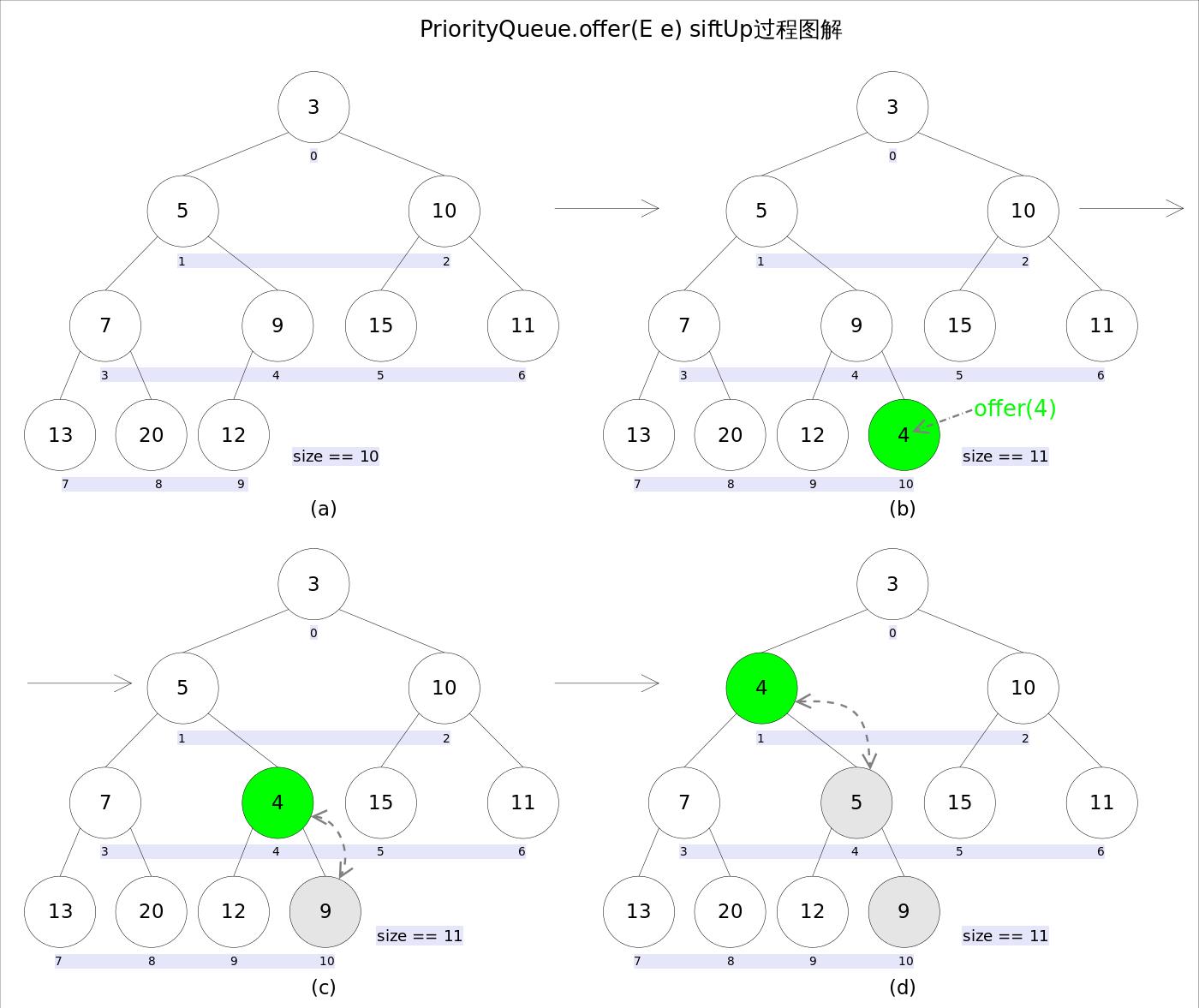
新加入的元素可能会破坏小顶堆的性质,因此需要进行必要的调整。
//offer(E e)
public boolean offer(E e)
if (e == null)//不允许放入null元素
throw new NullPointerException();
modCount++;
int i = size;
if (i >= queue.length)
grow(i + 1);//自动扩容
size = i + 1;
if (i == 0)//队列原来为空,这是插入的第一个元素
queue[0] = e;
else
siftUp(i, e);//调整
return true;
如上,扩容函数grow()类似于ArrayList里的grow()函数,就是再申请一个更大的数组,并将原数组的元素复制过去 。
需要注意的是siftUp(int k, E x)方法,该方法用于插入元素x并维持堆的特性。
//siftUp()
private void siftUp(int k, E x)
while (k > 0)
int parent = (k - 1) >>> 1;//parentNo = (nodeNo-1)/2
Object e = queue[parent];
if (comparator.compare(x, (E) e) >= 0)//调用比较器的比较方法
break;
queue[k] = e;
k = parent;
queue[k] = x;
新加入的元素x可能会破坏小顶堆的性质,因此需要进行调整。调整的过程为 : 从k指定的位置开始,将x逐层与当前点的parent进行比较并交换,直到满足x >= queue[parent]为止。注意这里的比较可以是元素的自然顺序,也可以是依靠比较器的顺序。

element()和peek()
//peek()
public E peek()
if (size == 0)
return null;
return (E) queue[0];//0下标处的那个元素就是最小的那个
-
element()和peek()的语义完全相同,都是获取但不删除队首元素,也就是队列中权值最小的那个元素,二者唯一的区别是当方法失败时前者抛出异常,后者返回null。
-
根据小顶堆的性质,堆顶那个元素就是全局最小的那个;
-
由于堆用数组表示,根据下标关系,0下标处的那个元素既是堆顶元素。所以直接返回数组0下标处的那个元素即可。

remove()和poll()
-
remove()和poll()方法的语义也完全相同,都是获取并删除队首元素,区别是当方法失败时前者抛出异常,后者返回null。
-
由于删除操作会改变队列的结构,为维护小顶堆的性质,需要进行必要的调整。
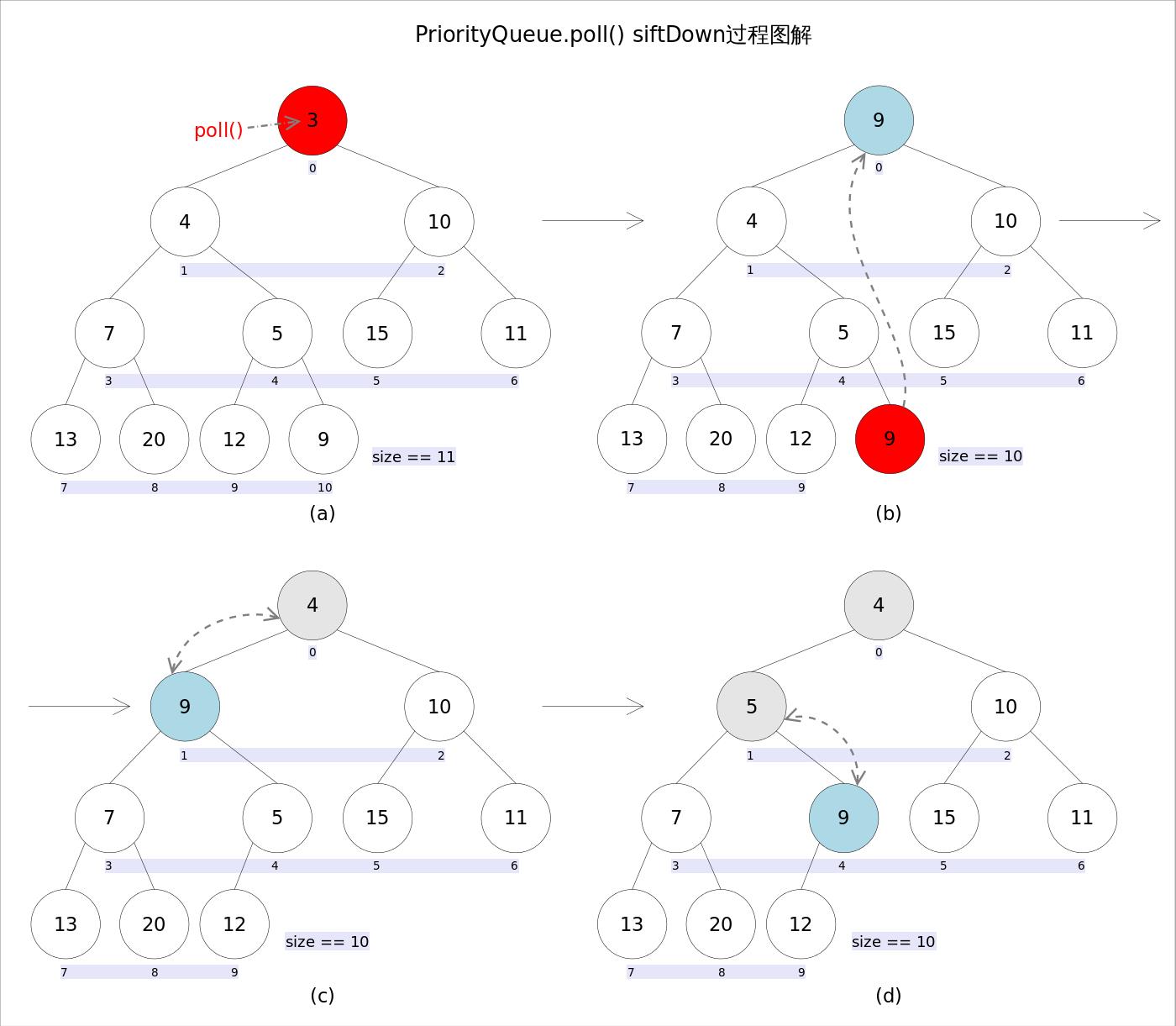
public E poll()
if (size == 0)
return null;
int s = --size;
modCount++;
E result = (E) queue[0];//0下标处的那个元素就是最小的那个
E x = (E) queue[s];
queue[s] = null;
if (s != 0)
siftDown(0, x);//调整
return result;
-
先记录0下标处的元素,并用最后一个元素替换0下标位置的元素,之后调用siftDown()方法对堆进行调整,最后返回原来0下标处的那个元素(也就是最小的那个元素)。
-
重点是siftDown(int k, E x)方法,该方法的作用是从k指定的位置开始,将x逐层向下与当前点的左右孩子中较小的那个交换,直到x小于或等于左右孩子中的任何一个为止。
//siftDown()
private void siftDown(int k, E x)
int half = size >>> 1;
while (k < half)
//首先找到左右孩子中较小的那个,记录到c里,并用child记录其下标
int child = (k << 1) + 1;//leftNo = parentNo*2+1
Object c = queue[child];
int right = child + 1;
if (right < size &&
comparator.compare((E) c, (E) queue[right]) > 0)
c = queue[child = right];
if (comparator.compare(x, (E) c) <= 0)
break;
queue[k] = c;//然后用c取代原来的值
k = child;
queue[k] = x;

remove(Object o)
-
remove(Object o)方法用于删除队列中跟o相等的某一个元素(如果有多个相等,只删除一个),该方法不是Queue接口内的方法,而是Collection接口的方法。由于删除操作会改变队列结构,所以要进行调整;
-
又由于删除元素的位置可能是任意的,所以调整过程比其它函数稍加繁琐。具体来说,remove(Object o)可以分为2种情况: 1. 删除的是最后一个元素。直接删除即可,不需要调整。2. 删除的不是最后一个元素,从删除点开始以最后一个元素为参照调用一次siftDown()即可.

//remove(Object o)
public boolean remove(Object o)
//通过遍历数组的方式找到第一个满足o.equals(queue[i])元素的下标
int i = indexOf(o);
if (i == -1)
return false;
int s = --size;
if (s == i) //情况1
queue[i] = null;
else
E moved = (E) queue[s];
queue[s] = null;
siftDown(i, moved);//情况2
......
return true;

以上是关于Java Review - PriorityQueue源码解读的主要内容,如果未能解决你的问题,请参考以下文章